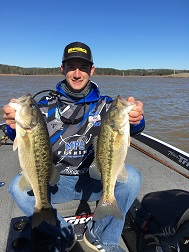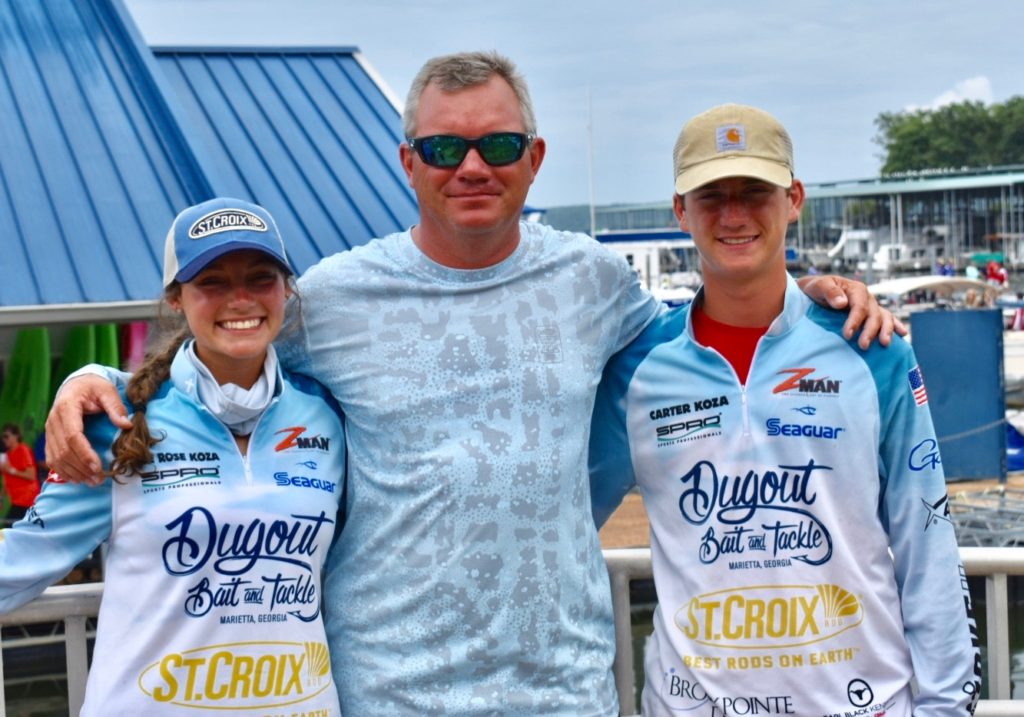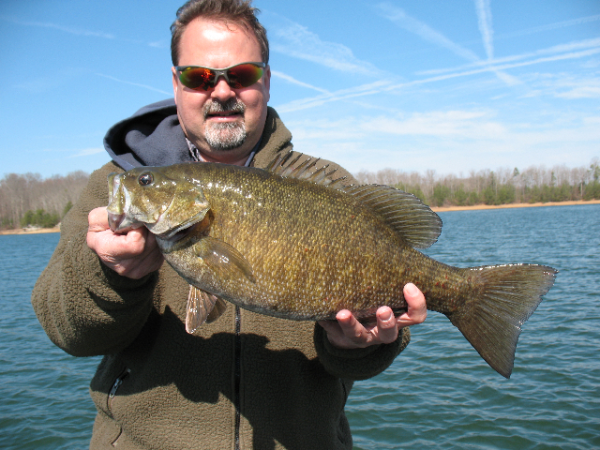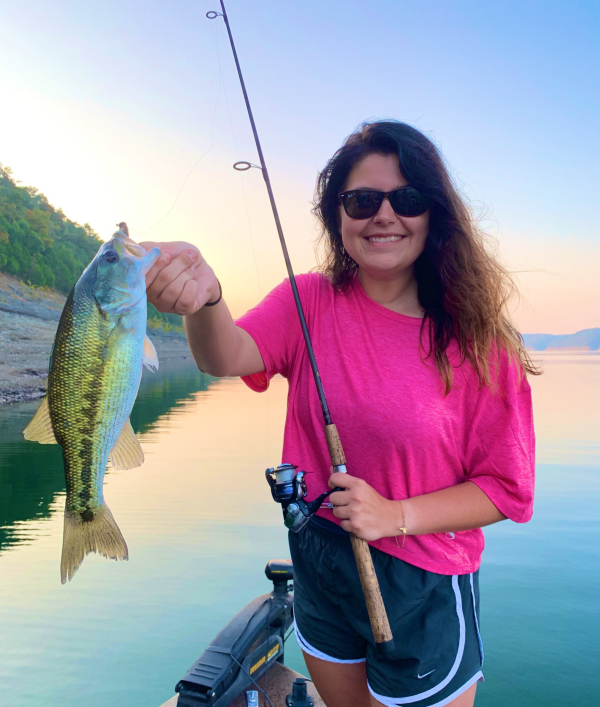February Bass at Guntersville
with Randall Tharp
Say the word “Guntersville” and bass fishermen all over the US perk up their ears. The lake has an almost mystical reputation for big stringers of bass, especially in late winter. This reputation has been built up over the years by the great catches there in tournaments and most of the national trails visit the lake each year.
From its dam near Guntersville in northeast Alabama the lake extends 76 miles up the Tennessee River into Tennessee. It is Alabama’s largest reservoir with waters covering 67,900 acres and 890 shoreline miles. It stays very stable since the TVA requires a set depth in its channels. Water will seldom vary more than two feet in depth which is good since vast areas of the lake are very shallow flats.
Built between 1936 and 1939, Guntersville has seen a lot of changes the bass population. The lake is very fertile and full of hydrilla and milfoil but one of the main reasons the bass are so big now is the size limit. On October 1, 1993 a 15-inch size limit was placed on bass. That size limit now includes smallmouth and largemouth and it allows smaller, faster growing bass to reach quality size.
According to the Alabama DCNR there are growing numbers of bass bigger than 15 inches in the lake each year and they are in good shape. The numbers of bass 12 to 24 inches long has consistently increased each year since the size limit went into effect. In the BAIT survey Guntersville has the highest weight per bass and the shortest time to catch a bass over five pounds of all lakes reported.
All this does not mean Guntersville is a piece of cake when it comes to catching keeper bass. The BAIT survey shows Guntersville ranking pretty far down the list in percent of angler success, number of bass per angler day and pounds of bass per angler day. If you don’t know the lake every acre of it looks like it holds bass and you can spend a lot of time with nothing but casting practice.
Randall Tharp knows the lake well. Although he has been fishing all his life he got started tournament fishing with a club about seven years ago and really liked it. He started fishing Guntersville in 2002 and now has a place on the lake. He has learned its secrets and has had great success there.
In 2007 Randall placed first in the point standings in both the Bama and Choo Choo Divisions of the BFL. He came in third in the Bama BFL on Guntersville last February then placed first in that division in September and second there in the Choo Choo Division the same month.
The past few years reads like a dream come true in Randall’s resume on Guntersville. In 2006 he placed second in the Bassmasters Series Crimison Divison in March and eighth in that series Volunteer Division the same month, won the seventh Annual Kickin’ Bass Coaches tournament there in June, got a fifth in the Bassmasters Series Crimsion Divison in September, and second in the Choo Choo BFL in September.
He also won the 2005 BITE Tournament on Guntersville in April and was second in the BITE Championship there in November. Guntersville has played an important part in Randall’s tournament winnings and has helped him get Ranger Boats and Chattanooga Fish-N-Fun as sponsors. He is planning on fishing the Stren Series and some other bigger trails like the BASS Opens if he can get in this year.
Randall gets excited when thinking about fishing Guntersville this time of year because he knows what lives in the lake. He says from now to March is the best time of year to hook a monster bass here and expects to catch some of the biggest fish of the year. When asked what it would take to reach “monster” status he said a 10 pound bass would qualify and he expects to catch one that big. He has seen bass in the low teens caught this time of year, too.
There are lots of ways to catch Guntersville bass from the end of January to March but Randall usually sticks with shallow water. He says the colder it gets the more shallow the big bass hold, and he seldom fishes deeper than 10 feet. You will be surprised at the numbers of big bass in less than three feet of water on the coldest days when the water is in the 30s, according to Randy.
Right now Randall will have a Rapala DT 6 or DT 10, a Cordell Spot or Rattletrap, a one quarter to three eights ounce jig and pig to cast, a Texas rigged Paca Craw with a heavy weight to flip in any thick grass he finds and Pointer jerkbait read to try. He likes shad colors in the crankbait and the red in the lipless baits. Worms and craws are usually green pumpkin and he also casts a black and blue jig and pig.
Although the grass is not growing much right now there is still some “stubble” on the bottom that will hold bass. Randall looks for flats near a drop and it helps to have grass on the bottom. He finds those kinds of places back in the creeks and out on the main lake but winter winds often make it impossible to fish open water. He likes to have some protected areas as well as open water to fish.
Bass don’t have to move much on Guntersville, according to Randall. They live in the same areas year-round, not migrating long distances like they do on some lakes. They will follow baitfish some but the grass provides so many bluegill on Guntersville that Randy thinks they are the major food source for bass.
Bass are predictable this time of year and Randall finds them in similar places each year. They move some but will usually be near a creek channel or ledge where there are good shallow water flats with grass stubble. They may concentrate in one area then move a little but they won’t move from the main lake to the back of a creek in a day or so. That helps when practicing for a tournament, but it also means many fishermen find the same fish.
No matter which bait you use it is important to fish as slowly as possible in the cold water. When your crankbait gets stuck in grass pop it loose gently and let it float up. Do the same with a Spot or Trap, popping it a little and letting it flutter back down. The bass don’t seem to want to chase a bait far, especially if it is moving fast, but Randall says they still hit hard. This time of year, even with the water in the 30s, will provide bone-jarring strikes and it feels like the bass will rip the rod out of your hand.
Randall and I fished on Guntersville in December and the bass were real scattered in the remaining hydrilla although the beds were getting sparse. Randy still landed about 20 bass that day and had two over five pounds. He could have weighed in five between 19 and 20 pounds, an excellent catch on most lakes but Randall was disappointed the big ones did not hit!
Check out the following ten spots. They run from near the dam to far up the river. Bass will hold on all of them this winter and there are other similar spots all over the lake. You just have to fish and find where the concentrations are to load the boat with big fish.
1. N 34 35.939 – W 86 33.106 – The long causeway crossing Brown’s Creek and the shallow humps downstream of it is one of the best places to catch a big bass this time of year. He says if he had to pick one place to land a ten pound bass he would never leave Brown’s Creek. Randy landed his best bass from Guntersville, 10 pound, 11 ounce hawg, from this area on a jerkbait. You can find areas on the riprap that is also more protected from the wind than the main lake.
Work around the riprap, especially the downstream side, with a jerkbait and both kinds of crankbaits. Also cast your a jig and pig on the rocks. Some days the fish will be near the rocks and others they will be holding a little deeper, the rocks in some places run out 18 to 20 feet deep. You can see on a good map there are points and drops near the riprap and hydrilla grows on the more shallow spots.
Downstream of the causeway but near it there are humps that rise to three or four feet deep and hydrilla forms mats on them in the summer. There will still be enough grass near the bottom to hold bass now. You may have to fish around the area while watching your depthfinder to locate these shallow spots.
Throw a Spot or Trap across them and follow up with a crankbait. Fish them very slowly. Once you locate some fish you can slow down and fish a jig and pig across these shallow areas. You should feel the grass on the bottom and that will help you locate the best spots. These humps are exposed to the wind.
2. N 34 40.711 – W 86 20.501 – Run up to the mouth of Town Creek and stop at the ramp on your right going in. Start fishing that bank working a lipless crankbait over the hydrilla that remains in the area. There is deep water near the point at the ramp and bass move up and down this bank feeding.
When you reach the back of the creek where Minky Creek splits to the left jump across and fish that creek, working it as you go in. You will see three big brick houses here and there are milfoil beds to fish. This creek is shallow and holds good fish this time of year.
Fish it all the way back in Minky Creek. Remember Randy says big bass are often in three feet of water or less this time of year and may be way back in the creek. Fish Traps and Spots and crankbaits. If you don’t get bites on them try a slower moving jig and pig or jerk bait.
3. N 34 42.026 – W 86 25.223 – Across the lake follow the channel markers going into Siebold Creek and stop when you get to the island on your left not far off the bank. Start fishing the islands from there to your left toward the back of that arm. There are humps, points and islands to fish along this side.
Fish are in this area now getting ready to stage for bedding. You can often catch several on a Trap or Spot from an area then work it with a black Enticer one-quarter ounce jig with a blue or black Zoom Chunk. Cast and fish it in the grass stubble on the bottom. Work it as slowly as possible.
Randall says fish the Trap and Spot right on the bottom, crawling it along and getting it stuck in the grass. Then pop it gently loose and let it fall back to trigger a strike. You will get many more hits if you fish it with an irregular action than if you just chunk and wind.
4. N 34 45.843 – W 86 19.364 – The bank downstream of Little Mountain Park has humps, grass and duck blinds. Randy says get on this bank, put your trolling motor down and fish, there are always lots of big bass holding in this area. Some of the humps come up to only a foot deep and there are cuts and holes that are nine to 10 feet deep.
The shallows near those holes are usually the hot spots. Some ditches cross the flat, making deeper holes. There is a grassline where the water drops deeper along here and the edge of the grass is the key. Fish a crankbait along the drop when you can. There is milfoil here and the breakline is always good.
You can work this whole area from the point at Meltonsville to the marina at Little Mountain. Fish over the grass with Trap and Spot but be sure to cast a jig to the duck blinds, too. Just make sure no hunters are present! By now that should not be a problem.
5. N 34 50.405 – W 86 17.087 – Pine Island is a huge grass island in the middle of the river out from Waterfront Grocery Fishing Tackle and Supplies. This is Randall’s favorite spot on the river year round. The river channel splits and goes on both sides of the grass and drops off 35 feet deep but the top of the island is only three or four feet deep. There is also a cut in the middle of the island that is more than 12 feet deep.
This area is so vast it is hard to fish. You can spend many hours here fishing what seem to be excellent grass lines and drops without catching anything, then hit a spot that is loaded with quality bass. For some reason they will school up in one small spot that seems to us to be just like the rest.
Fish a Trap, Spot and crankbait along the breaklines and over the grass until you find the sweet spot. Once you locate a good school of fish they should hold there for a good while. The head of the island creates a current break and the shallows near deep water make excellent structure for bass.
6. N 34 30.943 – W 86 09.017 – Run up to channel marker 372.2, a big marker on a pole. The South Sauty Creek channel runs into the river channel just upstream of this marker and the channel edges and grass lines along it are good this time of year. Work all your baits along both creek channels looking for concentrations of bass. Cuts and points on the old channels are good holding spots for the fish.
If you start near the channel marker and fish upstream you can follow the river channel. The break for the creek channel is not far from the channel and if you look almost straight up the river but a little to your right you will see the creek channel markers. It doe not run out straight from the creek but swings out then runs down parallel to the river for a long way.
Randall says you can start at the channel marker and fish up into the creek or stay on the river. You can fish the river ledge and grass stubble along it for seven miles going upstream and find schools of bass all along here. That gives you a good idea of the amount of water you have to cover to find schools of fish at times.
While fishing this spot and others Randall says to watch for any action on the water. Often a bass will chase a baitfish making it flick on top of the water giving away the position of a school of bass. It is always worth your time to go to any activity you see and fish around the area.
7. N 34 61.747 – W 86 11.057 – Run back into North Sauty Creek past the second bridge. Fish above the bridge around the lily pad stems, stumps and milfoil with lipless crankbaits and a light jig and pig.
This creek offers three causeways to fish and is more protected than the open river. Randall says you can start at the second bridge and work the creek edges all the way past the first bridge and out to the river channel. The first bridge has some riprap to fish. Also fish the bridge and riprap at Goose Pond on the side creek coming in.
The creek channel that winds across the flat downstream of Goose Pond Marina out to the main river channel is a good place to work carefully. There are a lot of tournaments at the marina and lots of fish are released there, restocking the area constantly. The concentration of keeper size bass is good here from those that are released. Randy says lipless crankbaits, shallow running crankbaits and a light jig and pig will catch them here.
8. N 34 60.472 – W 86.00.655 – Run up the river to the power lines. Both the outside channel ledge and the inside channel ledge from here to BB Comer Bridge have good grass stubble on them and holds a lot of fish. This time of year Randy likes to fish the back side of the ledge so work in behind the grass, too.
Keep your boat in 10 feet of water and cast out toward the river channel. You will be covering the ledge in about five or six feet of water. Work Traps and Spots as well as a lipped crankbait across this area. As in other places, watch for any change like a cut or rise and slow down when you catch a fish.
9. N 34 64.971 – W 86 00.000 – Go into the mouth of Rosebury creek back to the ramp on your left. Start fishing the bank across from the ramp working toward the back of the creek. Keep your boat near the creek channel and cast to the edges, working your bait over them. Fish all the way to the causeway in the back of the creek. There are stumps and milfoil to fish here.
This creek is where Randall has his camper and was his first stop in one of the BFL tournaments. He limited out here then went looking for bigger bass to cull. He often finds good numbers of bass back in this creek this time of year.
10. N 34 76.768 – W 85 90.325 – Go up to Mud Creek and in past the boat ramp. When the channel markers stop be careful but keep going to the second bridge and under it. The big area where the creek splits into Owen Branch and Blue Springs Branch often holds big bass this time of year. Back in this area are huge stumps near the creek channel and you don’t want to hit them with your motor, but they are what attracts the bass. There is also lots of shallow milfoil in this area.
Keep your boat in the channel and follow it, casting to both sides to hit stumps and other cover along the drop. You will be in about six feet of water and casting to very shallow water but Randall says this is where he found fish holding for several weeks when the water was 36 degrees and his rods were freezing up.
These places show you the kinds of cover and structure Randall looks for this time of year. You can fish them to get an idea of what to look for then find some similar spots of your own. These are big areas but the fish can be anywhere in them so take some time to find where they are holding. Once you get on them it will help you find them in other spots.



